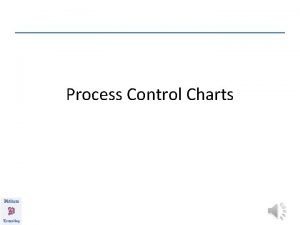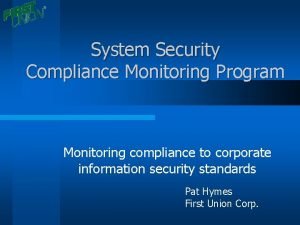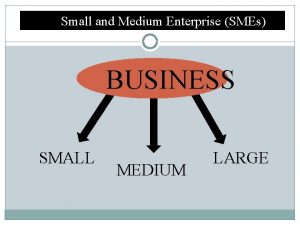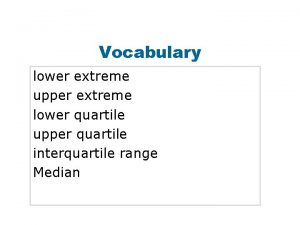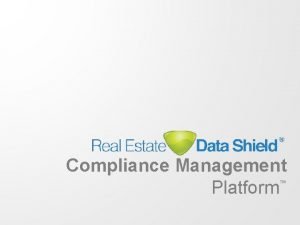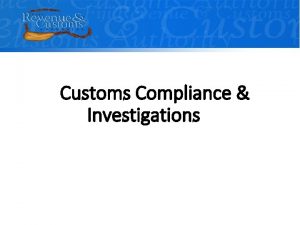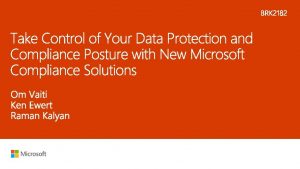Security Compliance for Small Lower Medium Upper Medium

































- Slides: 33

Security Compliance for Small, Lower Medium & Upper Medium Businesses www. netwatcher. com

What is Net. Watcher www. netwatcher. com

Compliance Creates Opportuni Security Sophistication Small Medium Large 5 M+ Threat Intelligence 10 k Solutions expensive opportunities Customer demands opportunities difficult to use 25 k and compliance mandatesopportunities HP security analysts HIPAA, FINRA, PCI-DSS, GBLA…. NIST 800 – 171, 23 NYCRR 500… don’t exist IBM MSSPs Managed Security Providers Security is the #1 Growth area for Managed Services Providers (MSPs)—Comp. TIA Fire. Eye Palo Alto Etc… SIEM End Point Technology Intrusion Detection Intrusion Protection …big gap… Firewall Anti-virus Size of Business www. netwatcher. com

SMB – ‘S’ & ‘M’ are Drastica According to the latest US Census, there are 7. 6 Million employer-based SMBs in the US. Or roughly 25% of all SMBs that actually have payrolls. # of Employees <20 20 -49 50 -99 100 -299 300 -499 500 -999 1, 0004, 999 721, 841 30, 828 9, 106 5, 811 1, 158 942 1, 290 291 458 628, 726 40, 552 12, 969 7, 465 1, 159 849 870 204 343 Health care and social assistance 539, 491 45, 348 15, 593 13, 841 2, 701 1, 887 1, 676 235 193 Accommodation and food services 379, 301 68, 002 18, 258 7, 878 1, 413 1, 018 747 115 122 Finance and insurance 232, 604 10, 612 4, 382 3, 410 719 536 693 169 263 Information Management of companies and enterprises Utilities 61, 292 6, 048 2, 257 1, 645 408 326 451 105 217 5, 295 2, 828 3, 270 6, 148 2, 620 2, 614 3, 350 670 814 4, 377 529 339 267 47 48 80 27 42 Educational services 60, 734 9, 326 4, 090 2, 698 540 552 525 56 99 Construction 697, 644 43, 101 12, 462 6, 264 877 527 438 66 95 Administrative 290, 893 20, 766 8, 311 6, 867 1, 709 1, 426 1, 503 302 413 Wholesale trade Real estate and rental and leasing Manufacturing 280, 185 27, 368 9, 736 6, 861 1, 451 1, 179 1, 378 279 347 269, 090 8, 087 2, 699 2, 034 486 419 505 110 212 208, 675 38, 891 16, 115 11, 593 2, 298 1, 769 1, 726 260 317 Transportation and warehousing Arts, entertainment, and recreation Agriculture, forestry, fishing and hunting Mining, quarrying, and oil and gas extraction 148, 967 11, 060 3, 871 3, 012 755 695 923 250 404 99, 357 9, 008 3, 568 2, 259 436 320 309 45 74 20, 491 861 242 189 32 17, 765 1, 849 680 532 114 Vertical Professional, scientific, and technical services Retail trade 5, 0009, 999 10, 000+ 22 50 7 17 Copyright © 2017 Net. Watcher All Rights Reserved. 103 164 31 50

Reality of a Small Prof. Svc. Business Owner… https: //www. sans. org/reading-room/whitepapers/analyst/security-spending-trends-36697 What can a company do with 15 k? www. netwatcher. com

Prof Svc Budgets https: //www. gartner. com/explore/tools/it-budget/survey/setup www. netwatcher. com

Reality of a Small Business 1. Executive is not aware of the risks – “We have a firewall and anti-virus so I think we are covered…” 2. Executive has bad information – “Hackers only attack the big companies, what would they want from us? ” 3. Executive is a risk taker – “I’ll take the risk, the probability for us getting attacked is low. ” 4. Executive is cheap – “No ROI means no priority. ” 5. Executive doesn’t believe investment in security is worth it– “The loss involved will be so small compared to our revenues. It’s easier to take a chance and write off any losses should they occur. ” 6. Executive is overwhelmed by the size of the necessary investment required to additional security measures – “We can’t afford Fire Eye, IBM, HP, Palo Alto etc. . those tools are only affordable to the fortune 1000” 7. Executive believes they are covered when they are not– “Our vendor are responsible for our security not us…” 8. Executive doesn’t believe any investment in cyber-security will have much of an impact– “Big companies have all the tools and they are still getting hacked. ” www. netwatcher. com

SMB Cyber Stats https: //smallbiztrends. com/2017/01/cyber-security-statistics-small-business. html • 43% of cyber attacks target small business. • Only 14% of small businesses rate their ability to mitigate cyber risks, vulnerabilities and attacks as highly effective. • 60% of small companies go out of business within six months of a cyber attack. • 48% of data security breaches are caused by acts of malicious intent. Human error or system failure account for the rest. • The numbers show that small businesses are not only at risk of attack, but have already been attacked: • 55% of respondents say their companies have experienced a cyber attack in the past 12 months(May 2015 -May 2016), and • 50% report they had data breaches involving customer and employee information in the past 12 months (May 2015 May 2016). • In the aftermath of these incidents, these companies spent an average of $879, 582 because of damage or theft of IT assets. • In addition, disruption to normal operations cost an average of $955, 429 www. netwatcher. com

SMB Cyber Stats https: //smallbiztrends. com/2017/01/cyber-security-statistics-small-business. html • While many small businesses are concerned about cyber attacks (58%), more than half (51%) are not allocating any budget at all to risk mitigation. • Dangerous disconnect: one of the more popular responses as to small businesses they don’t allocate budget to risk mitigation was that they, “feel they don’t store any valuable data. ” Yet a good number reported that they in fact DO store pieces of customer information that are of significant value to cyber criminals: • 68% store email addresses; • 64% store phone numbers; and • 54% store billing addresses. • Small businesses reported that only: • 38% regularly upgrade software solutions; • 31% monitor business credit reports; and • 22% encrypt databases. • If a company has a password policy, 65% of respondents say they do not strictly enforce it. 16% of respondents admitted that they had only reviewed their cybersecurity posture after they were hit by an attack. 75% of small businesses have no cyber risk insurance. www. netwatcher. com

So… There is a giant gap between the haves (Enterprise) and have nots (SMBs)… The reality is that SMBs are very far behind when it comes to enterprise security… www. netwatcher. com

Now… back to DFARS 252. 204. 7012 and NIST 800 -171 www. netwatcher. com

Example: I’m a small manufacturing company doing business with a prime contractor. www. netwatcher. com

I have to be compliant by December 2017 or risk losing my federal business. www. netwatcher. com

I’ve not been provided much guidance beyond the request to be compliant in the given timeframe. -I’m on my own… www. netwatcher. com

There are 14 families of security requirements associated with the NIST 800171 standard 1. Access Control 2. Audit and Accountability 3. Awareness and Training 4. Configuration Management 5. Identification and Authentication 6. Incident Response 7. Maintenance 8. Media Protection 9. Physical Protection 10. Personnel Security 11. Risk Assessment 12. Security Assessment 13. System and Communications Protection 14. System and Information Integrity www. netwatcher. com

BASIC SECURITY REQUIREMENTS (FROM FIPS PUBLICATION 200): Example for Configuration Management from Chapter 3, Requirement 4 in NIST 800 -171 3. 4. 1 Establish and maintain baseline configurations and inventories of organizational information systems (including hardware, software, firmware, and documentation) throughout the respective system development life cycles. 3. 4. 2 Establish and enforce security configuration settings for information technology products employed in organizational information systems. DERIVED SECURITY REQUIREMENTS (FROM NIST SPECIAL PUBLICATION 800 -53): 3. 4. 3 Track, review, approve/disapprove, and audit changes to information systems 3. 4. 4 Analyze the security impact of changes prior to implementation. 3. 4. 5 Define, document, approve, and enforce physical and logical access restrictions associated with changes to the information system. 3. 4. 6 Employ the principle of least functionality by configuring the information system to provide only essential capabilities. 3. 4. 7 Restrict, disable, and prevent the use of nonessential programs, functions, ports, protocols, and services. 3. 4. 8 Apply deny-by-exception (blacklist) policy to prevent the use of unauthorized software or deny-all, permit-by-exception (whitelisting) policy to allow the execution of authorized software. 3. 4. 9 Control and monitor user-installed software. www. netwatcher. com

Consider that many of the organizations faced with this requirement are in a bit of a quandary, considering the reality of never having had to protect CUI at this level before. They don’t want to lose these important customers but at the same time, they don’t have the people/experience, technology or money to solve it. www. netwatcher. com

“This rule will apply to all contractors with covered defense information transiting their information systems. Do. D estimates that this rule may apply to 10, 000 contractors and that less than half of those are small businesses. ” https: //www. gpo. gov/fdsys/pkg/FR-2015 -08 -26/pdf/2015 -20870. pdf Do they really understand the realities of the SMB? www. netwatcher. com

Even the SBA recognizes the issue… but there are no great answers… The reality is that SMBs are very far behind when it comes to enterprise security… www. netwatcher. com

A. DOD’s IRFA appears to be deficient. Number of Small Entities. Advocacy believes that DOD’s estimation of the number of small businesses affected by the rule is too low. DOD should include both small business prime contractors and small business subcontractors when estimating the number of small businesses impacted by the interim regulation. This rule will apply to all contractors with covered defense information transitioning their information systems. DOD estimates that 10, 000 contractors will be impacted by this rule and no more than 5, 000 will be small businesses. [8] It is unclear from DOD’s analysis DOD’s interim rule will significantly impact small businesses serving as prime contractors as well as small businesses servings as subcontractors. If DOD’s estimation only whether this estimation includes prime contractors, subcontractors, or both. As discussed below, includes small business prime contractors, Advocacy believes DOD has vastly underestimated the number of small businesses affected by this interim rule. Significant Alternatives. In the December 30 rule, as in the August 26 rule, DOD asserts that “[n]o significant alternatives, that would minimize the economic impact of the rule on small entities, were determined. ”[9] However, the Regulatory Flexibility Act (RFA) requires discussion of such alternatives as: “(1) the establishment of differing compliance or reporting requirements or timetables that take into account the resources available to small entities; (2) the clarification, consolidation, or simplification of compliance and reporting requirements under the rule for small entities; (3) the use of performance rather than design standards; and (4) an exemption from coverage of the rule, or any part thereof, for such small entities. ”[10] Consistent with the requirements under the RFA and to help alleviate the economic burden the interim final rule will place on small businesses handling covered information, Advocacy recommends that the Federal government consider either: • Collaborating with universities and other organizations to provide low-cost cybersecurity services to small businesses participating in the federal acquisition process. These institutions would provide services to supplant contracts with third-party vendors for assessments of information systems and security controls and for cybersecurity trainings and manuals for their employees; • Providing a one-time subsidy to small businesses participating in the federal acquisition process to help cover the cost of initial consultations with third-party vendors to assess their information systems and security controls for vulnerabilities. This one-time subsidy would be provided to these small businesses when they initially enter the federal acquisition process; or • Other significant alternatives as described by interested parties. Advocacy suggests that DOD provide the public with its analysis on each of these alternatives. Given that DOD determined the entire industry, both large and small businesses, needed additional time to comply with the August 26 rule, [11] DOD should at least consider a further extension of the compliance time for affected small businesses. https: //www. sba. gov/sites/default/files/2016_02_29_12_45_40. pdf www. netwatcher. com

B. The cost of compliance with DOD’s interim final rule will be a significant barrier to small businesses engaging in the federal acquisition process. Advocacy has received input from the small business community and cybersecurity experts that the cost of compliance is the single most pressing problem associated with the interim regulation. For small businesses, the compliance cost may be viewed through two separate compliance lenses. 1. Small Business Prime Contractors In the first lens, the small business prime contractor with DOD will clearly be required to implement the requirements of NIST SP 800 -171, according to the interim rule. Compliance for these small business prime contractors is very expensive as many small businesses will be forced to purchase services from outside vendors to provide “adequate safeguards” for covered defense information. Most small businesses have neither the technical expertise nor the information technology personnel or software to conduct these services in-house. • Software. The interim final rule will force small businesses to purchase additional software from third-party vendors, and will require small businesses to purchase any annual updates to that software thereafter. For example, cybersecurity experts have told Advocacy that small businesses will need to purchase software for tracking employee computer activity to fulfill the configuration management requirements. • Infrastructure. The interim final rule will force small businesses to purchase services from third-party vendors to fulfill the infrastructural requirements. For example, small businesses will be required to create redundant systems such as off-site, back-up servers for data retrieval in case of a cyber-incident. This costly service cannot be completed in-house by the vast majority of small businesses and could require contracting services from multiple vendors. Cybersecurity experts have also told Advocacy that small businesses will incur significant costs to establish adequate access controls such as encryption, multi-factor authorization, and separation of duties to prevent malevolent collusion. Specifically, multi-factor authorization would require contracting with an outside vendor and would be very expensive to implement. • Consultation. The interim final rule will force small businesses to seek risk and security assessments from third-party consultants. Small businesses will be required to periodically evaluate their information system and security controls and to reduce or eliminate any deficiencies or vulnerabilities. Cybersecurity experts have told Advocacy that small businesses are likely not cognizant of any deficiencies or vulnerabilities and would otherwise react to vulnerabilities and deficiencies as problems arise. Therefore, small businesses will need to contract with a third-party consultant to adequately assess their information systems and security controls. • Training. The interim final rule will force small businesses to either enroll employees in a third-party cybersecurity training course or contract with a vendor to produce an internal cybersecurity training regimen. Cybersecurity experts have told Advocacy that small businesses will not be able to supply adequate cybersecurity training in-house and will have to enroll employees in a third-party cybersecurity training course. In addition, small businesses will be required to contract with a third-party vendor to produce an internal cybersecurity manual. https: //www. sba. gov/sites/default/files/2016_02_29_12_45_40. pdf www. netwatcher. com

2. Small Business Subcontractors In the second lens, the DOD small business subcontractor may also be required to become compliant with the NIST requirements and the prime vendor may impose additional requirements that are not directly required in the NIST requirements but are required for the subcontractor under the terms and conditions of the DOD contract. For example, the interim final rule requires the contractor, both prime and subcontractor, to provide DOD with notification of a security breach within 30 days of the discovery of such a cyber-incident. Some acquisition experts are suggesting that large prime contractors may require their subcontractors to report such infractions to the prime much sooner than the time required by the regulation. [12] In addition, questions have been raised as to whether small business subcontractors will be required to maintain separate security systems for each of their large prime contractors. Clearly, the intent of this interim final rule is not to expand the burdens on contractors beyond that which is necessary to have compliance with NIST. This comment letter will not explore these types of subcontract issues in greater detail, but the DFARS should have affirmative guidelines in the final rule to address the concerns of the small business subcontracting community. [13] https: //www. sba. gov/sites/default/files/2016_02_29_12_45_40. pdf www. netwatcher. com

At the same time margins have never been lower and competition has never been more fierce… www. netwatcher. com

In the LPTA environment, you have two options; you can either (a) reduce your margins or (b) you can reduce the operating costs associated with the management and delivery of these contracts. Long term, of course, if your rates aren’t competitive, winning new awards without reducing your back-office costs is going to lead to disaster. http: //www. pvbs. net/government-contractors-must-get-leaner/ Jeremy Grant, chief development officer for Acquisition Solutions, which helps agencies develop requirements, says the average company in the S&P 500 earned about 8. 5% profit margin, while most government contractors work on a 5% profit margin. http: //govcentral. monster. com/benefits/articles/18679 -vendors-face-smaller-profit-margins-from-government-work www. netwatcher. com

The Cost of Compliance… • People to manage pre and post compliance • Build Policies – ex. Logical access policy • Build Procedures – Incident Response Plans • Hardware / Software Updates / Upgrades • Technology Maintenance Services to Keep Up • Cyber Training • Cyber Insurance Requirements • Legal support • New Required Security Capabilities www. netwatcher. com

Audit? IT Security for large DOD contractor: “If we ask, then we n there is liability. Anyway, this isn’t a security issue Procurement issue…” www. netwatcher. com

Example for HIPAA HHS’ Office for Civil Rights is responsible for enforcing the Privacy and Security Rules. Enforcement of the Privacy Rule began April 14, 2003 for most HIPAA covered entities. https: //www. hhs. gov/hipaa/forprofessionals/compliance-enforcement/ OCR enforces the Privacy and Security Rules in several ways: • • by investigating complaints filed with it, conducting compliance reviews to determine if covered entities are in compliance performing education and outreach to foster compliance with the Rules' requirements. OCR also works in conjunction with the Department of Justice (DOJ) to refer possible criminal violations of HIPAA. www. netwatcher. com

HIPAA’s Security Rule has been in place Since 2005 and many SMBs are still not compliant… The Final Rule on Security Standards was issued on February 20, 2003. It took effect on April 21, 2003 with a compliance date of www. netwatcher. com April 21,

Even NYCRR 500 has exemption Section 500. 19 Exemptions. Each Covered Entity with: 1. fewer than 10 employees, including any independent contractors, of the Covered Entity or its Affiliates located in New York or responsible for business of the Covered Entity 2. less than $5, 000 in gross annual revenue in each of the last three fiscal years from New York business operations of the Covered Entity and its Affiliates 3. less than $10, 000 in year-end total assets http: //www. dfs. ny. gov/legal/regulations/adoptions/dfsrf 500 txt. pdf www. netwatcher. com

Willing to make the investment How Many Reds Will There Be? x Yes $ No x No Yes Can Afford the Investment www. netwatcher. com

Potential Best Practices • Stage the rollout (learn from NY DFS NYCRR 500) • Clearly articulate who is responsible for enforcement and the process & liabilities • Clearly articulate the DOD’s expectations of the Prime contractor tactical responsibilities • Provide Tax incentive (similar to R&D tax credits) • Offer CBT training for SMB Cx. O’s with boilerplate policy / procedures • Consider Business Associate Contracts (HIPAA https: //www. hhs. gov/hipaa/for-professionals/covered-entities/sample-businessassociate-agreement-provisions/index. html? language=en ) By 8/28/2017 • Appoint a Chief Information Security Officer • Create an Incident Response Plan By 2/15/2018 • Submit your annual written statement (to the superintendent) covering the prior calendar year certifying that you are in compliance with the 23 NYCRR 500 requirements. By 3/1/2018 • Chief Information Security Officer will at a minimum once a year report on your cybersecurity program and material cybersecurity risks. • Conduct and document a periodic risk assessment • Institute the use of Multi-Factor Authentication • Create and manage a Cyber Training policy and program for all staff • Institute Continuous monitoring OR annual periodic Penetration Testing AND bi-annual vulnerability assessments. By 9/4/2018 • Document procedures used to limit user access privileges to Information Systems • Document procedures, guidelines and standards designed to ensure the use of secure development practices for in-house developed applications • Create and manage policy for Data Retention • Create and manage an Encryption policy for non-public information • Create and managed a record retention policy -- keep records required to reconstruct financial transactions for 5 years and keep cyber security event audit trails for up to three years. By 3/1/2019 • Document and manage policy for managing Third Party Service Provider Security www. netwatcher. com

https: //netwatcher. com

• http: //www. baesystems. com/en/what-wedo/suppliers/cybersecurity/level-1
 Private secuirty
Private secuirty Upper and lower bounds rules
Upper and lower bounds rules Greatest lower bound and least upper bound
Greatest lower bound and least upper bound Upper respiratory tract labeled
Upper respiratory tract labeled Upper and lower bounds 3 significant figures
Upper and lower bounds 3 significant figures Upper and lower respiratory tract
Upper and lower respiratory tract Upper and lower control limit formula
Upper and lower control limit formula Chuck allison
Chuck allison Upper specification limit and lower specification limit
Upper specification limit and lower specification limit Natural variations operations management
Natural variations operations management Programme upper lower
Programme upper lower Upper and lower bounds to 2 significant figures
Upper and lower bounds to 2 significant figures Sample and population difference
Sample and population difference Upper egypt and lower egypt
Upper egypt and lower egypt Upper vs lower epidermis
Upper vs lower epidermis What is the upper quartile of the data? 3 5 6 8
What is the upper quartile of the data? 3 5 6 8 Upper bound and lower bound in array
Upper bound and lower bound in array Laryngoscopy view grades
Laryngoscopy view grades Symmetric matrix multiplication
Symmetric matrix multiplication Upper lower bounds
Upper lower bounds Caina antenora ptolomea judecca
Caina antenora ptolomea judecca Uti upper and lower
Uti upper and lower Upper and lower bounds significant figures
Upper and lower bounds significant figures How to show roof slope on plans
How to show roof slope on plans What divided upper and lower egypt
What divided upper and lower egypt Upper lower class
Upper lower class Nearest whole number upper and lower bounds
Nearest whole number upper and lower bounds Crohn's disease vs ulcerative colitis
Crohn's disease vs ulcerative colitis Hot and cold media
Hot and cold media Vydj
Vydj Security compliance monitoring
Security compliance monitoring Microsoft azure security privacy and compliance
Microsoft azure security privacy and compliance Oeaa michigan
Oeaa michigan Life cycle of a low to medium mass star
Life cycle of a low to medium mass star






